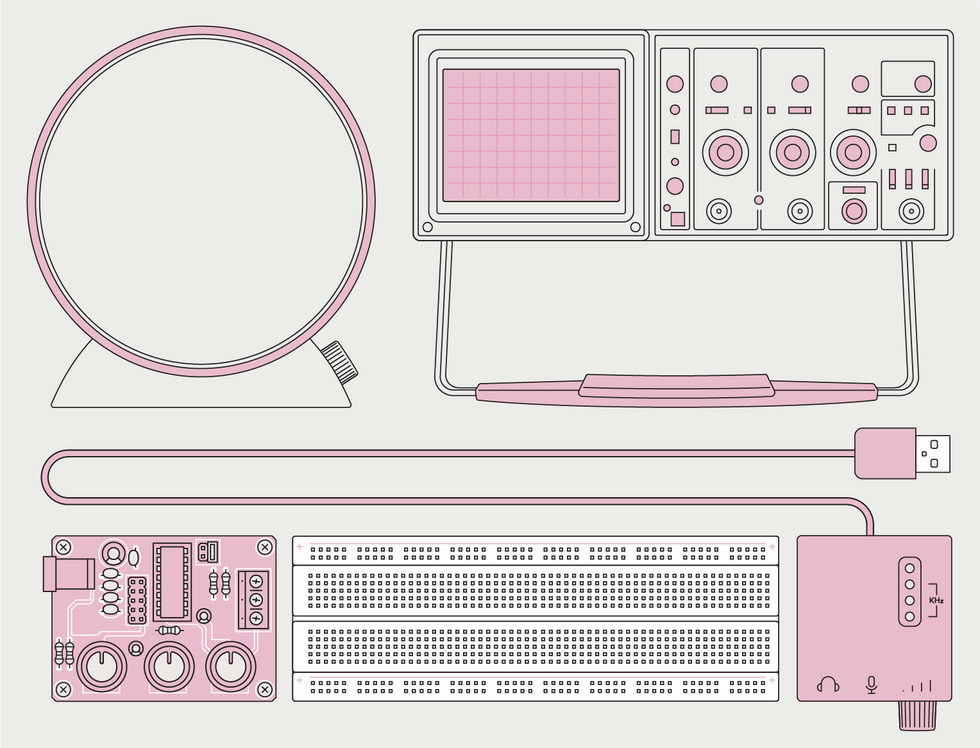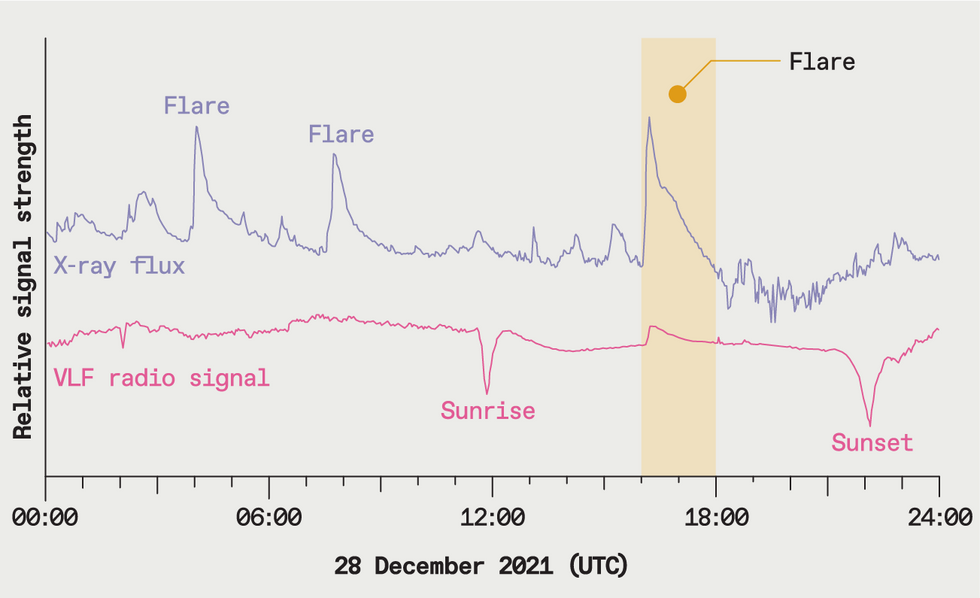Detect Solar Flares and Gamma-Ray Bursts for Less Than $100

In the 1960s and '70s, musicians would sometimes insert into their releases odd sounds that could be made intelligible only by rotating the vinyl record backward using your finger. If you suspect this is only an urban legend, load a digital version of Electric Light Orchestra's 1975 recording of Fire on High" into an audio editor like Audacity and play it in reverse. You'll hear ELO drummer Bev Bevan very clearly say, The music is reversible, but time...turn back, turn back, turn back."
In the 1980s, vinyl records gave way to compact discs, which weren't amenable to such backmasking." But at least one CD of that era contains a hidden message: Virgin Records' 1983 release of the album Tubular Bells, recorded a decade earlier at Richard Branson's Manor Studio in Shipton-on-Cherwell, England.
You see, an hour's drive north from Shipton is a suburb of Rugby called Hillmorton, where at the time the British government operated a very-low-frequency (VLF) radio station to send messages to submarines. It seems the powerful emanations from this nearby station, broadcast at a radio frequency of just 16 kilohertz (within the audio range), were picked up by the electronic equipment at Branson's studio and recorded at a level too low for anyone to notice.
After learning of this, I purchased an old CD of Tubular Bells, ripped a WAV file of one track, and piped it into a software-defined-radio package. Tuning to 16 kHz and setting the SDR software to demodulate continuous-wave signals immediately revealed Morse code. I couldn't copy much of it, but I could make out many repetitions of VVV (testing") and GBR (the station's call sign).
This inadvertent recording aptly demonstrates that VLF transmissions aren't at all hard to pick up. And these signals can reveal more than just the presence of a powerful radio transmitter nearby. The application I had in mind was to use changes in VLF-signal strength to monitor space weather.
 The solar-flare monitor consists of a coil antenna and external sound card," which connects to a laptop computer. Tuning the coil antenna to an appropriate frequency also required a signal generator, a protoboard, and an oscilloscope. James Provost
The solar-flare monitor consists of a coil antenna and external sound card," which connects to a laptop computer. Tuning the coil antenna to an appropriate frequency also required a signal generator, a protoboard, and an oscilloscope. James Provost
That's possible because these VLF transmissions travel over large distances inside the globe-encircling waveguide that is formed by the Earth's surface and the ionosphere. Solar flares-and rare astronomical events called gamma-ray bursts-can alter the ionosphere enough to change how radio signals propagate in this waveguide. I hoped to use VLF broadcasts to track such goings-on.
There's a long history of amateur astronomers using VLF radio equipment to measure solar flares by the sudden ionospheric disturbances (SIDs) they spawn. Years ago, it was a challenge to build suitable gear for these observations, but it now takes just a few modest Amazon purchases and a laptop computer.
The first item needed is a simple coil antenna. The model I bought (US $35) actually contains two coils. One was connected to a variable capacitor, so it can be tuned to various AM-broadcast frequencies; the other coil, of just two turns and inductively coupled to the first one, was wired to the output jack. I bypassed that two-turn coil and wired the jack directly to the wider coil, adding a couple of capacitors in parallel across it to lower its resonant frequency to 25 kHz.
There's a long history of amateur astronomers using VLF radio to measure solar flares by the ionospheric disturbances they spawn.
To choose the right capacitors, I purchased a $9 signal generator, also on Amazon, temporarily connected that wider coil in series with a 1,000-ohm resistor, and applied a sinusoidal signal to this circuit. I used an oscilloscope to identify the frequency that caused the alternating voltage across the coil to peak. With some experimentation, I was able to find a couple of ceramic capacitors (nominally 0.11 microfarads in total) to place in parallel with the coil to set the resonant frequency near the broadcast frequency of some U.S. Navy VLF transmitters.
Using a scrounged 3.5-mm plug, I then plugged the modified coil antenna into the mic input of an external sound card," having purchased one for $34 on Amazon that allowed a sampling rate of 96 kHz. This feature was key, because my plan was to tune into a station that the U.S. Navy operates in Cutler, Maine, which goes by the call sign NAA and broadcasts at 24 kHz. Fans of Harry Nyquist will remember that you need to sample a signal at least two times per cycle to capture it properly. So a typical sound card that samples at 44 kHz wouldn't cut it.
The final thing I needed was suitable software. I experimented with two SDR packages (HDSDR and SDR Sharp), with my sound card taking the place of the usual radio dongle. While these packages displayed transmissions from NAA clearly enough, they didn't provide a good way to monitor variations in signal strength over time. But I soon discovered how to do that with Spectrum Lab, following an online tutorial explaining how to use this software to measure SIDs.
 Within days of its construction, the monitor registered the signal from a solar flare . Two flares earlier that day, which were well documented in X-ray measurements taken by NASA's GOES-16 satellite in geosynchronous orbit [purple line], did not affect the VLF measurements [magenta line] because they occurred when the relevant part of the ionosphere was in darkness and shielded from the sun. James Provost
Within days of its construction, the monitor registered the signal from a solar flare . Two flares earlier that day, which were well documented in X-ray measurements taken by NASA's GOES-16 satellite in geosynchronous orbit [purple line], did not affect the VLF measurements [magenta line] because they occurred when the relevant part of the ionosphere was in darkness and shielded from the sun. James Provost
This combination of desktop AM antenna, external sound card, and Spectrum Lab software proved ideal. With it, I am not only able to monitor NAA, located about 1,400 kilometersfrom my home in North Carolina, I can also pick up the VLF station in LaMoure, N.D. (call sign NML), which transmits on 25.2 kHz. At times, I clearly receive the Jim Creek Naval station (NLK), near Oso, Wash., on 24.8 kHz and can even register the Navy's Aguada station in Puerto Rico, despite it transmitting at 40.75 kHz, far from my coil's resonant frequency.
The first few days of using this gear captured the expected pattern of daily variation in the signal from NAA, with sharp transitions when the sun rises and sets. Within a week, the sun became unusually active, producing three good-size flares in one day-as documented by NASA's Geostationary Operational Environmental Satellites, which measure X-ray flux in geosynchronous orbit. Two of those flares occurred when the East Coast was in darkness, so they had no effect on the relevant portion of the ionosphere or the signal strength I was monitoring. But the third, which took place at about 11 a.m. local time, showed up nicely.
It's rather amazing that with just $70 worth of simple electronics and a decade-old laptop, I can now monitor flares on the surface of the sun. One day I might see the effects of a gamma-ray burst taking place on a star in a distant galaxy, as a group at Stanford did in 2004. I'll probably have to wait years to detect one of those, though. In the meantime, I can entertain myself hunting for more radio signals inadvertently recorded at the Manor Studio in the '70s. Maybe I'll start those explorations, fittingly, with Van Morrison's 1978 album Wavelength.
This article appears in the February 2021 print issue as A Barometer for Space Weather."